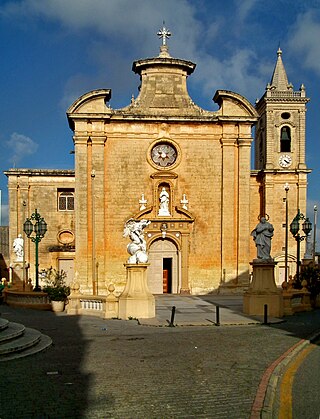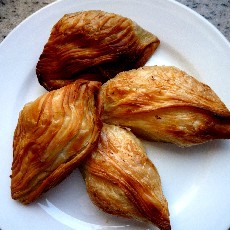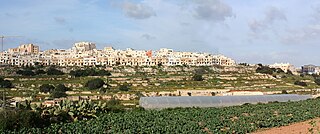The chamber of deputies is the lower house in many bicameral legislatures and the sole house in some unicameral legislatures.

Birkirkara is a city in the eastern region of Malta. It is the second most populous on the island, with 24,356 inhabitants as of 2020. The town consists of five autonomous parishes: Saint Helen, Saint Joseph the Worker, Our Lady of Mount Carmel, Saint Mary and San Gorg Preca. The city's motto is In hoc signo vinces, and its coat of arms is a plain red cross, surmounted by a crown.

Balzan is a municipality in the Central Region of Malta, one of the so-called three villages, together with Attard and Lija. The village originally consisted of a group of small dwellings and farms but eventually grew, becoming a parish in the 17th century. As of 2021, the town registered a population of 4,774 inhabitants.

Żejtun is a town in the South Eastern Region of Malta, with a population of 11,218 at the end of 2016. Żejtun is traditionally known as Città Beland, a title conferred by the grandmaster of the Order of the Knights of Malta, Ferdinand von Hompesch zu Bolheim in 1797. Before that, the village was known as Casale Santa Caterina, named after its patron saint and parish titular.

Għargħur is a village in the Northern Region of Malta. It is situated on a hilltop between two valleys, and has a population of 2,768, as of March 2014.

Msida is a harbour town in the Eastern Region of Malta with a population of 7,623 (2021).

Iklin is a village in the Central Region of Malta, with a population of 3,247 as at 2021. Iklin was established in the mid-20th century; however some archaeological sites and a medieval chapel, named as St. Michael Chapel, are proof to earlier settlements. Until recently, the town was considered to form part of the Three villages of Malta, as part of Lija. With the separation of Iklin from Lija, Iklin is no longer part of the three villages. It is bordered by Għargħur, San Ġwann, Birkirkara, Balzan and Naxxar.

A pastizz is a traditional savoury pastry from Malta. Pastizzi usually have a filling either of ricotta or curried peas. Pastizzi are a popular and well-known traditional Maltese food. It should not be confused with the Italian pastizz, better known as u' pastizz 'rtunnar.

Maltese architecture has its origins in prehistory, and some of the oldest free-standing structures on Earth – a series of megalithic temples – can be found on Malta. The islands were colonized by the Phoenicians and later the Romans, who established the cities of Melite and Gaulos. Although these were substantial settlements and are known to have had numerous temples, churches and palaces, few remains have survived apart from some architectural fragments.

Nazju Falzon was a Maltese cleric and a professed member from the Secular Franciscan Order. He did not become an ordained priest because he did not feel he was adequate enough for such an honor. He became an apt catechist and noted for his commitment to religious instruction.

Auberge d'Allemagne was an auberge in Valletta, Malta. It was built between 1571 and 1575 to house knights of the Order of Saint John from the langue of Germany.

The Parliament House is the meeting place of the Parliament of Malta located in Valletta, Malta. The building was constructed between 2011 and 2015 to designs by Renzo Piano as part of the City Gate Project, which also included building a new City Gate and converting the ruins of the Royal Opera House into an open-air theatre. Construction of the Parliament House generated considerable controversy, mainly due to the modern design of the building and the cost of construction, which amounted to around €90 million.

Tal-Wejter Tower is a tower in Birkirkara, Malta, which was built in the early 18th century by the Order of Saint John. It is also known locally as it-Torri tal-Misħun, a reference to its machicolations which are known as galleriji tal-misħun in Maltese. The tower was partially demolished in the 1960s, but it was later rebuilt. Today, it is in a rather dilapidated state.

Ta' Xindi Farmhouse, also known as the Ta' Xindi Headquarters and Kappara Outpost, is an 18th-century farmhouse built during the Order of St. John in San Ġwann, Malta. It was originally designed to be a farmhouse but went through different adaptive reuse.

Swatar, colloquially known as Is-Swatar and Tas-Swatar, is a hamlet in Malta situated in Birkirkara and in Msida. In 2015 it had a population of over 5,100 people, with around 1,600 families. Swatar has its own separate parish since 8 November 2006, by an official decree issued by the Bishop of Malta Monsignor Paul Cremona.

The Forni della Signoria was a bakehouse in Valletta, Malta. It was constructed in the late 16th century by the Order of St John, and it consisted of a number of bakeries which produced bread for the inhabitants of Valletta and the surrounding area, as well as for the Order's garrison and navy.
Robert Cutajar is a Maltese Nationalist politician, elected in the Maltese Parliament for the first time in the 12th legislature, with the opposition party. Previous to being elected, he has served as vice mayor between 1999 and 2001, local councilor between 2002 and 2005 and mayor between 2008 and 2013.

Villa St Ignatius is a historic villa located in the Balluta area of St Julian's, Malta. It was built in the early 19th century for the English merchant John Watson, and it might be the earliest example of Gothic Revival architecture in the country.

Ædes Danielis, sometimes known as Palazzo Gregorio Bonici, is a late 17th century renaissance building with a private garden in Żejtun, Malta. It is a historic private property built by Gregorio Bonici as his secondary residence, and is now owned by the descendants of the Bonici and Testaferrata families.

The Our Lady of Lourdes Parish Church is a Roman Catholic parish church in San Ġwann, Malta, dedicated to Our Lady of Lourdes. It forms part of the Roman Catholic Archdiocese of Malta. It is under the current administration of the Capuchin Order, with a community friars: Fr. Bertrand Vella ; Fr. Paul Bugeja; Fr. Valentine Calleja; Fr. John Vella; Br. Jesmond Ciantar; Fr. Leonard Falzon; and Fr. Publius Mair.























